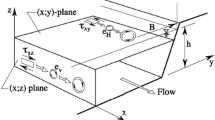Abstract
Wavelet transform is a particularly useful tool to characterize transient phenomena such as wave breaking. In this paper, we apply wavelet transform to the detection and quantification of the breaking waves. We use a new method that uses the local properties of wavelet transform to detect and quantify the breaking waves and give some new breaking criteria. By comparing this method with the classic method, we find that wavelet transform is very effective in the detection of breaking waves. With wavelet transform, a set of measured wind wave data is investigated. The results have revealed some previously unknown phenomena about wave breaking.
Similar content being viewed by others
References
Monahan EC. Oceanic whitecaps.J Phys Oceanogr, 1971, 1: 139–144
Farge M. Wavelet transforms and their applications to turbulence.Annu Rev Fluid Mech, 1992, 24: 395–457
Morlet J, Arens G, Fourgean I, Giard D. Wave propagation and sampling theory,Geophysics. 1982, 47: 203–236
Melville WK. Wave modulation and breakdown.J Fluid Mech, 1983, 128: 489–506
Bitner-Gregersen EM, Gran S. Local properties of sea waves derived from a wave record.Appl Ocean Res, 1983, 5: 210–214
Liu Paul C. Wavelet spectrum analysis and ocean wind waves. In: Efi Foufoula-Georgiou, Praveen Kumar, eds. Wavelet Analysis and Its Applications, Vol. 4, Wavelets in Geophysics. San Diego: Academic Press 1994. 151–166
Banner ML, Phillips WK. On the incipient breaking of small scale waves.J Fluid Mech, 1974, 65: 647–656
Phillips WK, Banner ML. Wave breaking in the presence of wind drift and swell.J Fluid Mech, 1974, 66: 625–640
Longuet-Higgins MS, Fox MJH. Theory of the almost-highest wave: the inner solution.J Fluid Mech, 1977, 80: 721–741
Longuet-Higgins MS, Smith ND. Measurement of breaking by a surface jump meter.J Geophys Res, 1983, 88: 9823–9831
Hwang PA, Xu D, Wu J. Breaking of wind-generated waves: measurements and characteristics.J Fluid Mech, 1989, 202: 177–200
Longuet-Higgins MS. A fractal approach to breaking waves.J Phys Oceanogr, 1994, 24: 1834–1838
Author information
Authors and Affiliations
Additional information
The project supported by the National Natural Science Foundation of China (49476254, 49606070) & the National High Technology Research and Development Program of China (863 Program)
Rights and permissions
About this article
Cite this article
Jinshan, X., Jiwei, T. & Enbo, W. The application of wavelet transform to wave breaking. Acta Mech Sinica 14, 306–318 (1998). https://doi.org/10.1007/BF02486869
Received:
Revised:
Issue Date:
DOI: https://doi.org/10.1007/BF02486869




